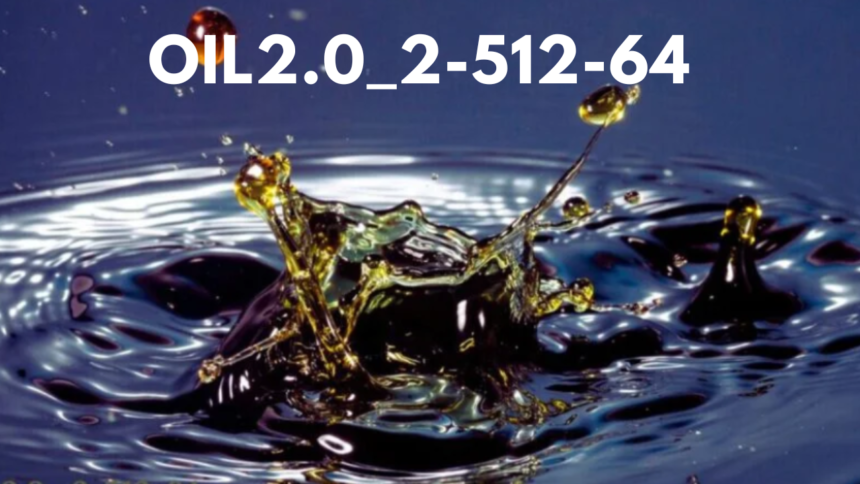The oil2.0_2-512-64 industry has long been a cornerstone of the global economy, providing the energy needed to power industries, transportation, and homes. However, the conventional methods of oil production have come under scrutiny in recent years due to their negative impact on the environment. The extraction and burning of fossil fuels contribute to greenhouse gas emissions and climate change, while oil spills and leaks can cause devastating harm to ecosystems.
There is an urgent need for a sustainable and green approach to oil production that can meet the world’s energy needs while minimizing its environmental footprint. This is where Oil2.0_2-512-64 comes into play. This revolutionary technology has the potential to transform the way oil is produced, making it more efficient, cost-effective, and environmentally friendly.
Understanding Oil2.0_2-512-64
Oil2.0_2-512-64 is a modern technology that represents the future of oil production. Unlike traditional methods that rely on drilling and extraction from underground reservoirs, Oil2.0_2-512-64 utilizes advanced techniques to extract oil from unconventional sources such as oil sands and shale formations.
The key difference between Oil2.0_2-512-64 and traditional oil production methods lies in its use of advanced robotics and artificial intelligence. These technologies enable precise and efficient extraction of oil, reducing waste and maximizing output. Additionally, Oil2.0_2-512-64 incorporates advanced filtration systems that minimize the release of harmful pollutants into the environment.
Technological Innovations in Oil2.0_2-512-64
Role of Robotics
Robotics plays a crucial role in the Oil2.0_2-512-64 process. Autonomous robotic devices are deployed in oil fields to navigate and extract oil from unconventional sources. These robots are equipped with advanced sensors and cameras that allow them to detect and analyze the composition of the oil, ensuring optimal extraction.
Application of Artificial Intelligence
Artificial intelligence (AI) is another key component of Oil2.0_2-512-64. AI algorithms analyze data collected by the robotic devices to optimize the extraction process. This includes identifying the most productive areas for extraction, adjusting the operation of the robots in real-time, and predicting potential issues before they arise.
Advanced Filtration Systems
Once the oil is extracted, it undergoes a series of filtration and purification processes to remove impurities and contaminants. Advanced filtration systems used in Oil2.0_2-512-64 ensure that the oil meets high-quality standards while minimizing environmental impact.
How Oil2.0_2-512-64 Works
Autonomous Robotic Devices
The Oil2.0_2-512-64 process begins with the deployment of autonomous robotic devices in oil fields. These robots are designed to operate independently, navigating through the oil field and identifying areas with high concentrations of oil.
Extraction Process
The robots use advanced drilling techniques to extract oil from unconventional sources. This involves precise drilling and extraction methods that minimize waste and maximize yield. The extracted oil is then transported through a network of pipelines to a central processing facility.
Transportation and Processing
At the central processing facility, the oil undergoes a series of filtration and purification processes. These processes remove impurities and contaminants, ensuring that the oil is of high quality and suitable for use. The purified oil is then ready for distribution and use.
Environmental Benefits of Oil2.0_2-512-64
Reduced Greenhouse Gas Emissions
One of the primary environmental benefits of Oil2.0_2-512-64 is the reduction in greenhouse gas emissions. The technology’s efficient extraction methods and advanced filtration systems result in lower emissions compared to traditional oil production methods.
Minimization of Oil Spills and Leaks
Oil2.0_2-512-64 also helps to minimize the risk of oil spills and leaks. The use of autonomous robotic devices reduces the likelihood of human error, while the advanced filtration systems ensure that any potential leaks are quickly detected and addressed.
Decreased Pollution
The advanced filtration systems used in Oil2.0_2-512-64 also contribute to a decrease in pollution. These systems remove harmful pollutants from the extracted oil, ensuring that the final product is cleaner and less harmful to the environment.
Economic Advantages of Oil2.0_2-512-64
Cost Savings for Oil Producers
Oil2.0_2-512-64 offers significant cost savings for oil producers. The technology’s efficient extraction methods result in higher yields and reduced waste, translating to lower production costs.
Increased Efficiency and Yield
The use of advanced robotics and artificial intelligence in Oil2.0_2-512-64 leads to increased efficiency and yield. The technology’s precise extraction methods ensure that more oil is extracted from each site, maximizing output.
Sustainable Resource Management
Oil2.0_2-512-64 promotes sustainable resource management by minimizing waste and maximizing the use of available resources. This ensures that oil production can continue to meet the world’s energy needs without depleting resources.
Challenges and Considerations
Initial Investment Costs
One of the main challenges associated with Oil2.0_2-512-64 is the initial investment cost. The technology requires significant upfront investment in robotics, AI, and advanced filtration systems.
Technological Adoption
Another challenge is the adoption of the technology. Oil producers may be hesitant to invest in new technology, especially if they are accustomed to traditional methods.
Regulatory Hurdles
Regulatory hurdles can also pose a challenge to the implementation of Oil2.0_2-512-64. Governments and regulatory bodies may need to update existing regulations to accommodate the new technology.
Case Studies and Examples
Successful Implementations of Oil2.0_2-512-64
Several oil producers have successfully implemented Oil2.0_2-512-64. These case studies highlight the technology’s potential to increase efficiency, reduce costs, and minimize environmental impact.
Comparisons with Traditional Methods
Comparisons between Oil2.0_2-512-64 and traditional oil production methods demonstrate the advantages of the new technology. These comparisons show that Oil2.0_2-512-64 offers higher yields, lower emissions, and reduced risk of spills and leaks.
Future Prospects of Oil2.0_2-512-64
Potential for Global Adoption
The potential for global adoption of Oil2.0_2-512-64 is significant. As oil producers seek to meet growing energy demands while minimizing environmental impact, the technology’s benefits are becoming increasingly attractive.
Ongoing Research and Development
Ongoing research and development are essential to the continued success of Oil2.0_2-512-64. Innovations in robotics, AI, and filtration systems will further enhance the technology’s efficiency and environmental benefits.
Long-term Sustainability
The long-term sustainability of Oil2.0_2-512-64 is a key consideration. By promoting efficient resource management and reducing environmental impact, the technology supports the goal of sustainable oil production.
Conclusion
Oil2.0_2-512-64 represents a significant advancement in oil production technology. By utilizing advanced robotics, artificial intelligence, and filtration systems, the technology offers numerous environmental and economic benefits. While there are challenges to overcome, the potential for global adoption and long-term sustainability makes Oil2.0_2-512-64 a promising solution for the future of oil production.
FAQs
What is Oil2.0_2-512-64?
Oil2.0_2-512-64 is a modern technology for oil production that uses advanced robotics and artificial intelligence to extract oil from unconventional sources like oil sands and shale formations.
How does Oil2.0_2-512-64 benefit the environment?
Oil2.0_2-512-64 reduces greenhouse gas emissions, minimizes the risk of oil spills and leaks, and decreases pollution through advanced filtration systems.
What are the economic advantages of Oil2.0_2-512-64?
The technology offers cost savings for oil producers, increased efficiency and yield, and promotes sustainable resource management.
Are there any challenges associated with Oil2.0_2-512-64?
Yes, challenges include initial investment costs, technological adoption, and regulatory hurdles.
What is the future of Oil2.0_2-512-64?
The future prospects for Oil2.0_2-512-64 are promising, with potential for global adoption, ongoing research and development, and long-term sustainability.









